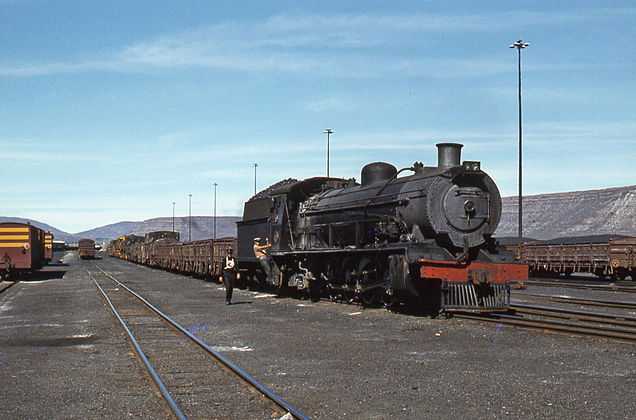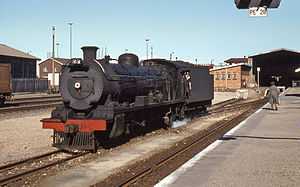South African Class 15 4-8-2
| South African Class 15 4-8-2 & South African Class 15AR 4-8-2 | |
|---|---|
|
No. 1566, reboilered and reclassified to Class 15AR, Port Elizabeth, 3 April 1978 | |
| Type and origin | |
| Power type | Steam |
| Designer | South African Railways |
| Builder | North British Locomotive Company |
| Serial number | 20364-20373 [1][2] |
| Model | Class 15 |
| Build date | 1914 [1] |
| Total produced | 10 |
| Specifications | |
| Configuration | 4-8-2 "Mountain" |
| Gauge | 3 ft 6 in (1,067 mm) Cape gauge |
| Leading wheel diameter | 28.5 in (724 mm) |
| Driver diameter | 57 in (1,450 mm) |
| Trailing wheel diameter | 33 in (838 mm) |
| Wheelbase |
Total: 63 ft 6.875 in (19.377 m) Engine: 6 ft 2 in (1.880 m) bogie 15 ft (4.572 m) coupled 33 ft 8 in (10.262 m) total Tender: 6 ft 2 in (1.880 m) bogie 20 ft 5 in (6.223 m) total |
| Length | 71 ft 6.5 in (21.806 m) |
| Height |
12 ft 10 in (3.912 m) as built 12 ft 11.75 in (3.956 m) reboilered |
| Frame | Plate frame |
| Axle load |
16.55 long tons (16.8 t) on 3rd driver as built 16.55 long tons (16.8 t) on 3rd driver reboilered, steel firebox 16.7 long tons (17.0 t) on 3rd driver reboilered, copper firebox |
| Weight on drivers |
66 long tons (67.1 t) as built 65.95 long tons (67.0 t) reboilered, steel firebox 66.2 long tons (67.3 t) reboilered, copper firebox |
| Locomotive weight |
94 long tons (95.5 t) as built 94.3 long tons (95.8 t) reboilered, steel firebox 94.85 long tons (96.4 t) reboilered, copper firebox |
| Tender weight |
61,520 lb (27.9 t) empty 66 long tons (67.1 t) w/o |
| Locomotive and tender combined weight |
187,320 lb (85.0 t) empty 160 long tons (162.6 t) w/o |
| Tender type |
MT - MP, MP1, MR, MS, MT, MT1, MT2, MX, MY, MY1 permitted * 2 axle bogies * 34 in (864 mm) wheels * Length 28 ft 5.375 in (8.671 m) |
| Fuel type | Coal |
| Fuel capacity | 12 long tons (12.2 t) |
| Water capacity | 6,000 imp gal (27,000 l) |
| Boiler |
As built: 5 ft 4.625 in (1.641 m) inside diameter 21 ft 9 in (6.629 m) inside length 7 ft 9 in (2.362 m) pitch Reboilered: 5 ft 7.5 in (1.715 m) inside diameter 21 ft 8 in (6.604 m) inside length, steel firebox 21 ft 7.625 in (6.594 m) inside length, copper firebox 8 ft 0.5 in (2.451 m) pitch |
| Boiler pressure |
185 psi (1,280 kPa) as built 190 psi (1,310 kPa) reboilered |
| Firegrate area |
40 sq ft (3.716 m2) as built 37 sq ft (3.437 m2) reboilered |
| Heating surface: – Tubes |
As built: 131 tubes 2.25 in (57.1 mm) diameter 24 tubes 5.5 in (140 mm) diameter 2,423 sq ft (225.104 m2) Reboilered: 87 tubes 2.5 in (63.5 mm) diameter 30 tubes 5.5 in (140 mm) diameter 2,171 sq ft (201.692 m2) |
| – Firebox |
155 sq ft (14.400 m2) as built 142 sq ft (13.192 m2) reboilered |
| – Total |
2,578 sq ft (239.504 m2) as built 2,313 sq ft (214.885 m2) reboilered |
| Superheater area |
601 sq ft (55.835 m2) as built 537 sq ft (49.889 m2) reboilered |
| Cylinders | Two |
| Cylinder size |
22 in (559 mm) bore 28 in (711 mm) stroke |
| Valve gear | Walschaerts |
| Performance figures | |
| Tractive effort |
At 75% boiler pressure: 32,990 lbf (146.7 kN) as built 33,880 lbf (150.7 kN) reboilered [3] |
| Career | |
| Operator(s) |
South African Railways Swaziland Railway |
| Class | Class 15, Class 15AR |
| Number in class | 10 |
| Number(s) | 1561-1570 |
| Delivered | 1914 |
| First run | 1914 |
The South African Class 15 4-8-2 of 1914 is a South African steam locomotive from the South African Railways era.
In 1914 the South African Railways placed ten Class 15 steam locomotives with a 4-8-2 Mountain type wheel arrangement in service.[4]
Manufacturer
The Class 15 was introduced by D.A. Hendrie, Chief Mechanical Engineer (CME) of the South African Railways (SAR) from 1910 to 1922, as a large mixed traffic locomotive for use in the Orange Free State where grades and curvature were less severe than on the coastal sections. Designs were prepared in 1913 for this locomotive, similar in general layout to the Class 12 and Class 14, but with larger 57 inches (1,450 millimetres) coupled wheels. Ten locomotives were built by the North British Locomotive Company (NBL) and delivered in 1914, numbered in the range from 1561 to 1570.[2]
They had plate frames, Walschaerts valve gear, Belpaire fireboxes without combustion chambers and were superheated. In order to reduce the weight on the trailing wheels, steel fireboxes were used. This last feature became standard on large locomotives, but it necessitated the introduction of water treatment plants in some parts of the country to prevent corrosion.[2][4][5]
The locomotive’s one flaw was excessively long fire tubes. On later models like the Class 15A Hendrie improved the boiler by adding a combustion chamber and shortening the distance between tube plates from 21 feet 9 inches (6.629 metres) to 19 feet (5.791 metres) in the process.[2]
Watson Standard boilers
During the 1930s many serving locomotives were reboilered with a standard boiler type designed by A.G. Watson, CME of the SAR from 1929 to 1936, as part of his standardisation policy. Such Watson Standard reboilered locomotives were reclassified by adding an "R" suffix to their classification.[3][4]
When all ten Class 15 locomotives were reboilered with Watson Standard no. 2A boilers, they were reclassified to Class 15AR since the only differences between the as-delivered Class 15 and the Class 15A lay in the length of their boilers and whether they were built with or without combustion chambers. In the process they were also equipped with Watson cabs, with their distinctive slanted fronts, compared to the conventional vertical fronts of their original cabs. Some were equipped with steel and others with copper fireboxes.[4]
An obvious visual difference between an original and a Watson Standard reboilered locomotive is usually a rectangular regulator cover just to the rear of the chimney on the reboilered locomotive. In the case of the Class 15 and Class 15AR two even more obvious visual differences are the Watson cab and the absence of the Belpaire firebox hump between the cab and boiler on the reboilered locomotives.[3]
Service
The Class 15 was placed in service in the Orange Free State, stationed at Bloemfontein. After reboilering and reclassification they became part of the much larger Class 15AR fleet and saw service widely throughout the country, getting used in every kind of role from dock shunting to mainline passenger work.[2][4]
The Cape Northern examples were scattered between De Aar, Kimberley and Klerksdorp. The Cape Midland was a major user of the class, with locomotives shedded at Sydenham in Port Elizabeth, Klipplaat, Graaff Reinet and Noupoort. The Class 15AR also handled the suburban services between Port Elizabeth and Uitenhage until they were replaced by diesel power.[5]
Near the end of their service lives in the early 1980s they were all relegated to shunting work at centres all around the country, except for some that were hired out to Swaziland and that were still employed in mainline service on the Swaziland Railway, until they were also eventually replaced by diesel traction and retired.[5]
Modifications illustrated
The main picture, showing the reboilered and reclassified Class 15AR no. 1566 at Port Elizabeth, and the following illustrate the Class before and after modification.
-
.jpg)
Class 15 no. 1563 as built, circa 1914, with its as-delivered tender and Belpaire firebox
-

No. 1568 reboilered and reclassified to Class 15AR, Midlandia yard, Noupoort, 1 April 1979
See also
- List of South African locomotive classes
- South African Class 15A 4-8-2
- South African Class 15B 4-8-2
- South African Class 15C 4-8-2
- South African Class 15CA 4-8-2
- South African Class 15E 4-8-2
- South African Class 15F 4-8-2
- South African locomotive history
- Tender locomotive numbering and classification
- The 4-8-2 "Mountain"
- Watson Standard boilers
References
|
- ↑ 1.0 1.1 North British Locomotive Company works list, compiled by Austrian locomotive historian Bernhard Schmeiser
- ↑ 2.0 2.1 2.2 2.3 2.4 Holland, D.F. (1972). Steam Locomotives of the South African Railways, Volume 2: 1910-1955 (1st ed.). Newton Abbott, Devon: David & Charles. p. 26. ISBN 978-0-7153-5427-8.
- ↑ 3.0 3.1 3.2 South African Railways and Harbours Locomotive Diagram Book, 2’0” & 3’6” Gauge Steam Locomotives, 15 August 1941, as amended
- ↑ 4.0 4.1 4.2 4.3 4.4 Paxton, Leith; Bourne, David (1985). Locomotives of the South African Railways (1st ed.). Cape Town: Struik. pp. 10–11, 59–60. ISBN 0869772112.
- ↑ 5.0 5.1 5.2 Durrant, A E (1989). Twilight of South African Steam (1st ed.). Newton Abbott, London: David & Charles. pp. 83–84. ISBN 0715386387.
